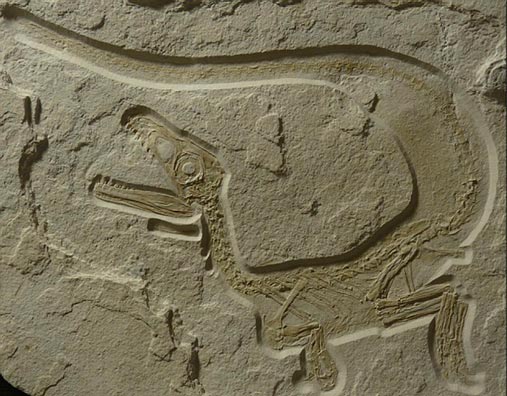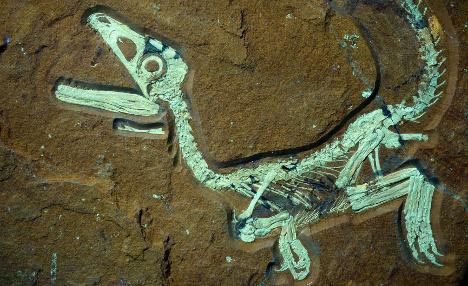Megalosaurs join the Dinosaur “Tufty” Club
German Fossil Discovery Suggests all Meat-Eating Dinosaurs May have been Feathered
The discovery of a beautifully preserved and very nearly complete fossil of a baby meat-eating dinosaur in Germany has ruffled a few feathers in the field of palaeontology. An analysis of this baby member of the theropod group known as the Megalosauridae, shows that this youngster had bristle-like feathers covering its body. This is the first time evidence of a feathered dinosaur from the megalosaur clade has been detected and the first time a fossil of a feathered dinosaur has been found in Europe.
Megalosauridae
Most scientists accept that a number of dinosaurs were indeed feathered. The feathers were not for flight, but the main function seems to have been to help insulate these active animals, to help keep them warm. However, most feathered theropod fossils had been up to now associated with the Liaoning deposits of northern China. This strata represents sediments laid down in the Early Cretaceous. In addition, feathered theropods known to date are ascribed mostly to the Coelurosauria, this new discovery suggests that other types of theropod, a megalosaur, also might have possessed feathers.
To read about the recent discovery of a dinosaur related to T. rex that also may have been feathered: The One Tonne Basal Tyrannosaur.
Dr Oliver Rauhut, conservator at the Bavarian Collection for Palaeontology and Geology studied the 98% complete fossil along with colleagues and their findings have just been published in the American scientific journal “The Proceedings of the National Academy of Sciences”.
A spokesperson from Everything Dinosaur stated:
“This is an amazing fossil, it looks too good to be true, as if it has been carved into the rock, but detailed tests have proved that this is indeed the fossilised remains of a baby dinosaur from the Late Jurassic”.
The Beautifully Preserved German Dinosaur
Picture credit: Dr Helmet Tischlinger
The seventy-two-centimetre-long baby shows typical juvenile traits such as the disproportionately large head and the presence of large orbits (eye-sockets) in the skull. The fossil represents a new species of Tetanuran (stiff-tailed) theropod dinosaur, it has been ascribed to the megalosaurs and given the scientific name Sciurumimus albersdoerferi. The genus name is derived from “Sciurus” – for squirrel; a reference to the filamentous structures seen around the long tail under ultra-violet light. It seems that this little dinosaur may have had a bushy tail just like a squirrel. The specific name honours the private collector who helped bring this fossil discovery to light.
Very few of the bones are missing so the research team had the opportunity to study an almost complete dinosaur skeleton, perhaps one of the most complete ever found and certainly the most complete specimen of a theropod dinosaur found in Europe to date.
The actual fossils were recovered from a limestone quarry in Southern Germany, (Bavaria). Although the research team can’t be sure how this baby dinosaur met its end, but its near perfect preservation and discovery in marine deposits suggest that this youngster drowned.
Once subjected to ultra-violet light, the remains of skin and the fibrous filaments that covered this animal’s body can be picked out.
Exposing the Fossil of Sciurumimus albersdoerferi to UV Light
Picture credit: Dr Helmet Tischlinger
Dr Tischlinger, one of the authors of the study commented:
“Under ultraviolet light, one can see the remains of skin and the plumage as luminous spots and fibres on the skeleton.”
The scientists are unable to calculate just how big S. albersdoerferi would have been when an adult, although other types of megalosaur dinosaur were apex predators in Europe during the Late Jurassic and some members of this clade reached lengths in excess of six metres and weighed more than a 1,000 kilogrammes. The German team have been able to write a paper on an exceptionally preserved baby dinosaur skeleton, a noncoelurosaurian theropod that had filamentous plumage at the base of its slender tail and elsewhere on its body.
Sciurumimus albersdoerferi
The filaments are similar in structure to the bristle-like structures found on the ornithischian dinosaur Psittacosaurus,(from Mongolia and China), as well as being similar to the primitive tyrannosaur Dilong and the therizinosaur Beipiaosaurus (both also Chinese dinosaurs). As a European dinosaur, this new fossil find, will help scientists to piece together the relationship between different types of dinosaur and the different types of integumentary structures found in the Dinosauria.
For Everything Dinosaur team members, there are a number of other important elements to this particular fossil, not just the presence of feathers. For example, this is a baby dinosaur fossil and such fossils are extremely rare. The small bones of baby dinosaurs are seldom preserved in the fossil record and to have the chance to study such a complete specimen was described by one team member as “simply astonishing”. We are not sure what the Reverend William Buckland, who was given the task of naming and describing the first dinosaur, ironically another megalosaur (Meglosaurus bucklandii), would have made of this new discovery, however, it is helping to clear up some of the issues relating to megalosaur classification. The complete absence of a fourth digit on the hand is assisting scientists as they clarify the anatomical details that pertain to the megalosaurs as members of the Tetanurans.
The jaws show the teeth in such detail that the research team have been able to see that the teeth of this baby megalosaur are remarkably similar to the teeth of basal coelurosaurs. This suggests that a number of dinosaur discoveries may have been misidentified in the past, with isolated fossilised teeth being ascribed to the coelurosaurs when they could actually have belonged to a megalosaur.
A fascinating discovery, one that will yield more secrets no doubt, but for the moment we at Everything Dinosaur are just happy to see a member of the Megalosauridae in the dinosaur “tufty” club.
To view Megalosaurus models and other dinosaur figures: Megalosaurs and Theropod Dinosaur Models (CollectA Age of Dinosaurs).



